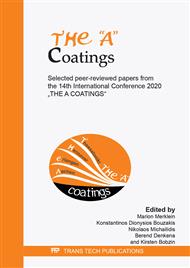p.3
p.11
p.19
p.28
p.39
p.45
p.53
p.61
Investigation on the Wear Behavior of Coatings for Lubricant-Free Deep Drawing Processes with a Novel Application-Oriented Test Rig
Abstract:
Lubricant-free deep drawing is motivated by the avoidance of using environmentally harmful lubricants as well as the potential for shortening the process chain by eliminating lubricant application and component cleaning. Central challenges of dry deep drawing are a significant increase in friction as well as in adhesive tool wear due to a lack of a separating lubricant layer between tool and workpiece. An approach to meet these challenges is the modification of the tools through diamond-like coatings. Based on findings from laboratory tests, a-C:H and ta-C coatings were selected and their effectiveness in overcoming these challenges was demonstrated in single stroke tests in previous research. In order to use the process-specific advantages of forming technology, high tool life is required. In this context, this research aims at investigating the application behavior of a-C:H and ta-C coatings during lubricant-free deep drawing of a high number of components made of the aluminum alloy AA5182. For this purpose, a new wear test rig is applied, which enables the time and material efficient production of high quantities. Numerical methods are utilized to identify the drawing die radius as well as the blank holder as the highest loaded areas. Based on these findings, the wear of the coatings as well as that of an uncoated tool as a reference is analyzed in these areas by optical and tactile measurements. In addition, the influence of tool wear on the component surface quality is determined. It is proven that the ta-C coating increases the tool life from 10 components in uncoated condition up to 3,000 components.
Info:
Periodical:
Pages:
11-18
Citation:
Online since:
October 2020
Authors:
Keywords:
Price:
Сopyright:
© 2020 Trans Tech Publications Ltd. All Rights Reserved
Share:
Citation:


